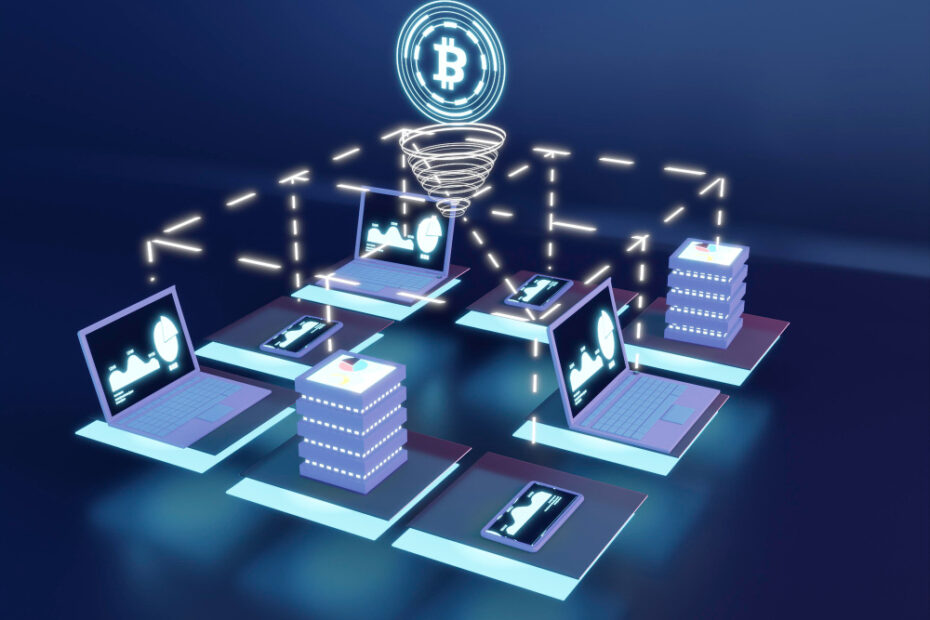Blockchain technology has revolutionized various industries by introducing decentralized and transparent systems. One of the most compelling uses of blockchain is in the development of decentralized applications (DApps). Unlike traditional applications, DApps run on a peer-to-peer network, offering enhanced security, transparency, and resilience. This guide will walk you through the fundamentals of blockchain development, focusing on building and deploying decentralized applications, including the creation of smart contracts.
What is a Decentralized Application (DApps)?
A Decentralized Application (DApp) is an application that operates on a decentralized network, typically a blockchain. DApps utilize smart contracts—self-executing contracts with the terms of the agreement directly written into code. Here are some key characteristics of DApps:
- Decentralization: DApps operate on a decentralized network, ensuring no single point of failure.
- Transparency: Transactions and data are publicly verifiable on the blockchain.
- Security: Enhanced security through cryptographic principles and distributed ledger technology.
- Incentives: Often use tokens to incentivize network participants.
Benefits of DApps
1. Enhanced Security
DApps offer a higher level of security due to their decentralized nature. In traditional centralized applications, data is stored in a single location or server, making it an attractive target for hackers. If the server is compromised, all data can be accessed and potentially altered or stolen.
In contrast, DApps distribute data across a network of nodes, making it extremely difficult for hackers to target a single point of failure. Each node holds a copy of the entire blockchain, and any changes to the data must be validated by the majority of the network. This distributed ledger technology ensures that data is secure, transparent, and immutable. Additionally, transactions and data within DApps are encrypted using advanced cryptographic techniques, further enhancing security and reducing the risk of breaches.
2. Transparency and Trust
One of the cornerstone benefits of blockchain technology, and by extension DApps, is transparency. All transactions and data changes are recorded on a public ledger that is accessible to everyone on the network. This transparency ensures that all actions taken within the DApp are visible and can be independently verified by any participant.
This immutable ledger builds trust among users, as they can be confident that the data has not been tampered with. In industries such as finance, where trust is paramount, this transparency can prevent fraud and ensure compliance with regulations. Similarly, in supply chain management, transparency helps track products from origin to delivery, ensuring authenticity and reducing the risk of counterfeit goods.
3. Improved Resilience
Traditional centralized systems are vulnerable to a single point of failure. If the central server goes down due to technical issues, cyber-attacks, or maintenance, the entire application becomes unavailable. This can lead to significant downtime and disrupt business operations.
DApps, on the other hand, are built on decentralized networks, meaning there is no single point of failure. The network continues to operate even if several nodes go offline. This decentralized architecture provides a higher level of resilience against failures and attacks. If one part of the network is compromised, the rest of the network can continue to function without interruption, ensuring continuous availability and reliability of the application.
4. Cost Efficiency
DApps can significantly reduce transaction fees and operational costs by eliminating intermediaries. In traditional applications, intermediaries such as banks, payment processors, and other third parties facilitate transactions, often adding significant fees and delays to the process.
By using smart contracts on a blockchain, DApps can automate and streamline transactions without the need for intermediaries. Smart contracts are self-executing contracts with the terms directly written into code, which execute transactions automatically when predefined conditions are met. This automation reduces the need for manual intervention, lowers the cost of transaction processing, and speeds up the overall process.
Furthermore, DApps can operate on a peer-to-peer network, reducing infrastructure costs associated with maintaining central servers and databases. These cost efficiencies can lead to more competitive pricing for services and products, benefiting both businesses and consumers.
Additional Benefits of DApps
5. Censorship Resistance
DApps operate on decentralized networks, making them less susceptible to censorship by authorities or centralized entities. This characteristic is particularly valuable in regions with restrictive regulations or where freedom of speech and access to information are at risk. Since the control is distributed among network participants, it becomes challenging for any single entity to censor or control the application.
6. Tokenization and Incentives
Many DApps incorporate tokenization, creating their own cryptocurrency tokens that can be used within the application. These tokens can serve various purposes, such as providing access to services, incentivizing user participation, and facilitating governance decisions. Tokenization aligns the interests of users and developers, promoting active engagement and contribution to the DApp’s ecosystem.
7. Innovation and Collaboration
The open-source nature of many blockchain platforms encourages innovation and collaboration among developers worldwide. DApps can be built on existing platforms, leveraging shared resources and protocols to create new applications and services. This collaborative environment fosters rapid development and the continuous improvement of DApps, driving the evolution of decentralized technologies.
Getting Started with Blockchain Development

1. Choosing the Right Blockchain Platform
Selecting the appropriate blockchain platform is crucial for the success of your DApp. Here are some popular platforms:
- Ethereum: The most popular platform for DApps due to its robust smart contract functionality and large developer community.
- Binance Smart Chain (BSC): Known for lower transaction fees and faster processing times compared to Ethereum.
- Polkadot: Offers interoperability between different blockchains.
- Solana: Recognized for high-speed transactions and low fees.
2. Setting Up the Development Environment
To start developing on a blockchain, you need to set up your development environment. This typically involves:
- Installing Node.js: Required for running JavaScript-based development tools.
- Installing Truffle Suite: A development environment, testing framework, and asset pipeline for Ethereum.
- Installing Ganache: A personal blockchain for Ethereum development you can use to deploy contracts, develop applications, and run tests.
3. Writing Smart Contracts
Smart contracts are the backbone of DApps. They are self-executing contracts with the terms of the agreement directly written into code. Smart contracts are typically written in Solidity, Ethereum’s contract-oriented programming language.
Key Elements of a Smart Contract:
- State Variables: Store the data of the contract.
- Functions: Define the behavior of the contract.
- Events: Allow logging of activity in the contract, which can be used for notifications or tracking purposes.
Developing the DApps
4. Designing the Architecture
A well-structured architecture is crucial for the efficiency and scalability of your DApp. It typically involves:
- Client-Side Interface: The front-end part of the DApp that users interact with.
- Smart Contracts: The back-end logic running on the blockchain.
- Off-Chain Components: Parts of the application that don’t require blockchain for operation, such as databases for storing non-essential data.
5. Front-End Development
To create a user-friendly interface for your DApp, you will need to build a front-end. This involves:
- Creating the User Interface (UI): Use HTML, CSS, and JavaScript to build the interface where users will interact with your DApp.
- Connecting to the Blockchain: Use libraries like Web3.js to connect your front-end to the blockchain and interact with your deployed smart contracts.
Interacting with the Blockchain
6. Using Web3.js
Web3.js is a JavaScript library that allows you to interact with the Ethereum blockchain. It enables the front-end of your DApp to send transactions, call smart contract functions, and listen for blockchain events.
7. Setting Up Metamask
Metamask is a browser extension that serves as an Ethereum wallet and allows users to interact with DApps. It manages users’ keys and enables transactions and smart contract interactions directly from the browser.
Testing Your DApp
Testing smart contracts is crucial to ensure they function as intended. Unit tests should cover all functions and scenarios, including edge cases and failure conditions.
9. Integration Testing
Integration testing ensures that the smart contracts and front-end of your DApp work together seamlessly. It involves simulating user interactions and verifying that the DApp behaves as expected.
10. User Acceptance Testing (UAT)
Before launching your DApp, conduct user acceptance testing to gather feedback from real users. This helps identify usability issues and areas for improvement.
Deploying Your DApp
11. Deploying Smart Contracts
Once your smart contracts are thoroughly tested, deploy them to the mainnet. This involves sending the compiled contract code and initialization parameters to the blockchain.
12. Hosting the Front-End
Host your DApp’s front-end on a web server or decentralized storage service like IPFS (InterPlanetary File System). Ensure that it is accessible and can interact with the deployed smart contracts.
13. Registering on DApp Browsers
Register your DApp on popular DApp browsers and directories to increase visibility and attract users. This includes platforms like DappRadar and State of the DApps.
Post-Deployment Consideration
14. Monitoring and Maintenance
- Monitor Performance: Regularly monitor the performance of your DApp to ensure it runs smoothly. Use analytics tools to track usage and identify potential issues.
- Security Audits: Periodically conduct security audits to detect and fix vulnerabilities in your smart contracts and DApp.
- Updating Smart Contracts: While smart contracts are immutable, you can implement upgradeable contract patterns to make updates and improvements.
15. Community Engagement
- Build a Community: Engage with your users and the broader blockchain community. Use forums, social media, and events to build a community around your DApp.
- Feedback Loop: Encourage users to provide feedback and suggestions. Use this feedback to continuously improve your DApp.
Challenges in DApp Development
While developing Decentralized Applications (DApps) offers numerous benefits, it also comes with its own set of challenges:
1. Scalability
Handling a large number of transactions can be difficult on some blockchain platforms. Due to the decentralized nature of blockchain, each transaction must be validated by multiple nodes, which can lead to network congestion, slower transaction times, and higher fees as user activity increases. Solutions like layer 2 scaling and transitioning to more scalable consensus mechanisms are being explored to address these issues.
2. Security
Ensuring the security of smart contracts is crucial, as any vulnerabilities can be exploited. Once deployment, smart contracts are immutable, so any bugs or flaws cannot be easily fixed. Developers must rigorously test and audit their smart contracts, often employing third-party security firms, and use best practices like formal verification to mitigate security risks.
3. User Experience
Creating a seamless and user-friendly experience can be challenging due to the complexity of blockchain technology. Users often struggle with managing private keys, understanding gas fees, and navigating blockchain transactions. Developers need to focus on building intuitive interfaces and abstracting blockchain complexities to make DApps more accessible. Integrating solutions like Metamask can help streamline the user experience.
4. Integration with Existing Systems
Interoperability with traditional systems can be difficult. Many enterprises operate on legacy systems that are not designed to interact with blockchain technology. Developing robust APIs and middleware to facilitate communication between blockchain and traditional systems is essential, as is ensuring data consistency and security during integration.
5. Regulatory and Compliance Issues
Navigating legal landscapes is complex as the regulatory environment for blockchain technology and cryptocurrencies evolves. Developers must stay informed about legal implications, including compliance with data protection laws, financial regulations, and anti-money laundering requirements. This requires legal expertise and proactive compliance measures, which can vary significantly by jurisdiction.
Conclusion
Building decentralized applications (DApps) using blockchain technology offers numerous benefits, including enhanced security, transparency, and decentralization. By following this guide, you can get started with blockchain development, from writing and deploying smart contracts to building and testing your DApp. Despite the challenges, the potential rewards make it a worthwhile endeavor, offering innovative solutions and opportunities in the evolving landscape of blockchain technology.
